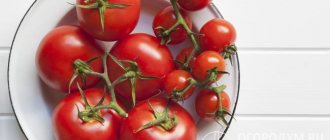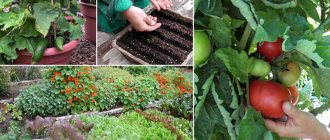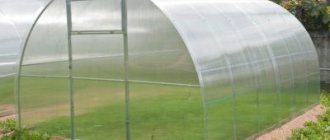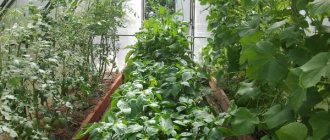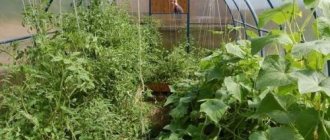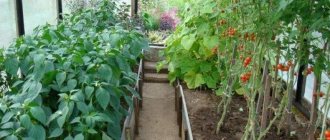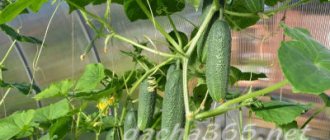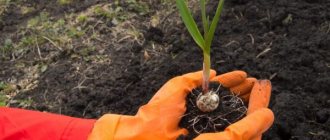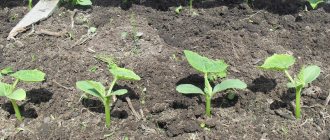We invite you to find answers to the most popular questions about growing tomatoes, including talking about the compatibility of vegetables and telling you what can be planted together, before and after tomatoes.
- Is it possible to plant cucumbers and tomatoes in the same greenhouse?
- Is it possible to plant peppers and tomatoes?
- Is it possible to plant eggplants with tomatoes?
- Is it possible to plant cucumbers in the place where tomatoes grew?
- Is it possible to plant tomatoes after potatoes, garlic or cabbage?
- Is it possible to plant strawberries after tomatoes?
- Is it possible to plant two tomato seedlings in one hole?
- Is it possible not to pick tomato seedlings?
- Is it possible to grow tomatoes in an apartment?
Is it possible to plant cucumbers and tomatoes in the same greenhouse?
Cucumbers and tomatoes cannot be planted together in industrial greenhouses. Cucumbers require more watering and moisture. Tomatoes, on the contrary, prefer drier air. But if you don’t plant 100 cucumber bushes and 100 tomato bushes and you don’t have the opportunity to build your own greenhouse for each crop, plant cucumbers and tomatoes in the same greenhouse, but in different beds. You just need to water the tomatoes less and the cucumbers more often.
Bans are good in theory, but in practice everyone has been growing cucumbers and tomatoes together for a long time
Find out all the secrets of growing tomatoes and cucumbers in greenhouses here >>>>>>>>>>
Optimal conditions for growing crops
If you decide to grow tomatoes and cucumbers together under one shelter, then the best way to create more or less acceptable conditions for them is physical separation. The crops must be planted in different parts of the structure and a film partition must be installed between them. This technique will allow you to control the air humidity in the room and the ventilation of the tomato plantings. The separator must pass not only along the top, but also along the ground. This is necessary to control soil moisture. Between plantings, it is best to dig in a sheet of roofing material or iron.
In the part intended for tomatoes, it is necessary to make 2 vents that will provide through ventilation. In the compartment adapted for cucumbers, one window is needed.
Low compatibility of crops suggests the exclusion of such agrotechnical measures as a steam room for cucumbers.
Compromise microclimatic indicators for the joint cultivation of both crops in a greenhouse are as follows:
- daytime temperature - +25°C;
- night temperature - +20°C;
- air humidity - 70%.
Is it possible to plant peppers and tomatoes?
Peppers and tomatoes can be planted in the same greenhouse, but in different beds. Both peppers and tomatoes are light- and heat-loving crops, so it is necessary to carefully consider the planting scheme so that some plants do not block the light for others. Low varieties can be combined in a staggered planting, or peppers can be planted in the foreground. When planting seedlings in a greenhouse, you should first plant tomato bushes in the ground, and only then place pepper seedlings between them. After planting tomatoes, pepper plants will not experience a shortage of space and light.
When planting peppers and tomatoes in a greenhouse, take into account common diseases and be on the alert
Soil: Both tomatoes and eggplants require well-drained soil with a pH between 5.5 and 7.5. You can add compost or well-rotted manure to add nutrients to the soil.
Watering: These nightshades need regular and deep watering (at least once a week) for good yield.
Tomatoes and peppers belong to the same family, the nightshade family (Solanum). Accordingly, tomatoes and peppers are susceptible to the same diseases, including late blight. You will need annual replacement of the top layer of soil and careful maintenance.
You can find out how to get a good pepper harvest in this article >>>>>
What crops get along well next to cucumbers?
To get a big harvest, gardeners and gardeners often resort to little tricks. This applies not only to fertilizers, soil and bait, but also to the choice of which crop to plant next to other plants. These secrets will help you get a larger harvest, retain moisture during dry periods, nourish the soil and get original fruits.
Mixed planting of vegetables in the garden will help improve the condition of the plants, retain moisture during the dry period, and improve the taste and nutritional value of the fruit.
Tomatoes, cucumbers, peppers
Every summer resident plants in his plot or garden those fruits, berries or vegetables that are in demand and that he always wants to see on the table. Often these are tomatoes, peppers and cucumbers.
Cucumber seedlings should be planted in warm soil, and if you expect an early harvest, then plant them under film.
You can plant cucumbers using tricks to ensure that the fruits are smooth and have a full set of vitamins. There is an opinion that you need to plant plants in beds, alternating root crops and bush plants, but this is not entirely true. When planting cucumbers on your plot, you should pay more attention to your neighbors in the plantation, since a lot depends on the correct planting of crops.
Planting tricks that should be taken into account
Scheme of mixed planting of vegetables.
It cannot be said that cucumbers are capricious when growing in the garden, but they are quite vulnerable, so you need to follow some tricks that can not only protect the vegetables, but also strengthen their growth and promote a good harvest. It is known that cucumbers consist of 95% water; accordingly, they love watering and moisture, which means you need to choose a place for them that will be in the shade during the hottest days. If you can’t plant vegetables in such a place, then you can resort to a method such as “smart neighborhood”. You can plant cucumbers next to those plants that will keep the bushes in the shade. It is recommended to plant corn next to cucumbers. It has been noticed that corn stalks protect cucumbers from the wind and scorching sun. In addition, in hot weather, corn is able to retain moisture in the ground, creating shade, and cucumbers love moisture.
Planting cucumbers next to legumes improves the growth and fruitfulness of vegetables.
To improve the growth and fruitfulness of vegetables, you can plant cucumbers next to legumes; such a proximity will benefit all plants. But plants such as onions or garlic next to cucumbers will not benefit the neighbors, but will slow down growth and have a detrimental effect on the development of weaving. However, dill and its varieties, according to experts, will be a favorable neighbor for cucumbers.
You cannot plant cucumbers and tomatoes, a golden rule that every gardener knows. Despite the fact that these vegetables complement each other perfectly in salads, they do not get along in the same bed; both plants will deteriorate.
Vitamins in fruits
Do not forget that it will not be possible to get a good harvest from land that is “poor” in minerals, but if you did not have time to fertilize the land where cucumbers grow, then plant early crops next to them, that is, those plants that grow early. bear fruit. After neighboring plants have produced a harvest, all the vitamins that remain in the roots can fill the cucumber fruits. For example, beets will grow and bear fruit well next to cucumbers. You couldn't find a more successful neighborhood. At the same time, the carrots will suffer from the fact that the cucumber is located nearby.
Sunflower protects cucumbers from moisture loss, and the strong stem of sunflower crops is an excellent support for cucumber vines.
You cannot plant cucumbers next to aromatic herbs, the growth of vegetables will be slowed down, and the fruits will not be able to be filled with vitamins. Radishes will also interfere with the development of the cucumbers' root system, which, of course, will harm the yield. But the calendula flower will be a favorable neighbor for cucumbers, as summer residents note, these crops growing nearby contribute to each other’s development. According to professional vegetable growers, sunflower will be able to protect cucumbers from loss of moisture in strong winds, and if the soil does not dry out, then the fruits will be juicy. In addition, the strong stem of sunflower crops will be an excellent support for cucumber vines, and you will not have to come up with special devices for tying. Spinach, Chinese cabbage and celery will also contribute to the good development of cucumbers.
It is also worth considering that cucumbers cannot be planted in the same place for more than 3 years, the yield will be very low and the fruits may lose their taste. Change the area in which the cucumbers will grow every year to encourage a good harvest.
If cucumbers grow in comfortable conditions, then nothing can prevent them from being filled with solar energy and nutrition from the soil. By following some recommendations for planting vegetables, you can enjoy juicy fruits that will bring you benefits and many vitamins. Consider the correct rotation of vegetables in the beds to enjoy a rich harvest. And many summer residents put good and durable fruits in jars to enjoy excellent crispy cucumbers in winter. What could be better on the table in winter than cucumbers, reminiscent of summer, filling the house with an amazing aroma.
VseoTeplicah.ru
It must be remembered that a certain microclimate is created in the greenhouse, that is, the temperature and humidity in the greenhouse differ from these indicators outside. And different cultures require different living conditions.
In addition, in a greenhouse, plants compete for light and nutrients as space is limited, which also affects the choice of neighboring crops.
Is it possible to plant eggplants with tomatoes?
Both tomatoes (Solanum lycopersicum) and eggplants (Solanum melongen) are members of the nightshade family and require the same conditions for a successful harvest. These two related plants can grow together in greenhouses and outdoor beds as companion plants, but they require certain conditions to grow. Use the following tips to successfully plant tomatoes and eggplants. Growing conditions are similar to those listed above, where we talked about growing tomatoes and peppers together.
Tomato and eggplant roots are close to the surface, so be careful not to uproot the plants when weeding. Applying mulch from grass clippings or straw will help control weeds without damaging the plants.
When planting eggplants and tomatoes, consider the need for sufficient lighting
Tomatoes and eggplants are susceptible to the same diseases, such as verticillium wilt and late blight. These diseases live in the soil and spread to plants, causing leaf necrosis and reduced yield. Be sure to follow preventive measures.
Read more about tomato diseases here >>>>>>>>
Tomatoes and eggplants grow leafy and tall, so leave enough space between them for air circulation. Also make sure that the sun will reach all parts of the foliage. This will prevent the appearance of shady, damp areas where pathogenic mycelium can form. Position plants so they receive at least six hours of full sun each day. This prevents excessive shading, which can cause the eggplant roots and stems to become over-watered.
Soil for cucumbers
- A distinctive feature of this plant is its increased requirement for carbon dioxide, which should be in the range of 0.3-0.5% in the air. Therefore, it is useful to fertilize cucumbers with solutions containing manure - when it decomposes, a lot of CO2 is released.
- A balanced soil composition is important. For this reason, it is necessary to use complex fertilizers containing macro- and microelements.
- The acidity of the soil for cucumbers should be close to neutral. Not higher than 7.0 and not lower than 6.5. Depending on these indicators, lime is used to reduce it or peat to increase it.
- The microflora of the earth should not be toxic, but, on the contrary, “alive”. But at the same time, you should not allow fungal spores, insect larvae and pathogens to get into it. And to prevent those that already exist from becoming more active, massive decomposition processes must not be allowed in the soil. And for this point, it is better to take land for seedlings away from the roadway.
- For a young plant, looseness and porosity of the soil is important for uniform distribution of moisture. Therefore, sand can be added to loamy soils, but clay should not be added for seedlings.
- Especially for greenhouses, it would be good to add one of these components to the soil: leaf humus, peat, wood ash, moss, crushed eggshells, humus or grain husks.
Is it possible to plant cucumbers in the place where tomatoes grew?
When planting vegetables, an important rule of crop rotation is to leave a three-year period between re-planting melons (cucumbers, squash and pumpkins) and nightshade crops (potatoes, tomatoes, eggplants and peppers). Ideally, different types of plants should not be grown within three years of each other. So if you want to grow tomatoes, potatoes, peppers and eggplants, you need to plant different areas at different times, constantly changing the combinations. When you combine tomatoes and cucumbers in the same space year after year, the same substances are washed out of the soil and the same disease-causing spores are introduced. Over time, you will lose in the quality and quantity of your harvest if you do not replace the soil and follow disease prevention measures.
Everything about growing cucumbers is waiting for you here >>>>>
Is it possible to plant tomatoes after potatoes, garlic and cabbage?
Tomatoes and potatoes are very bad neighbors because they incredibly attract late blight early. And since they belong to the same family - the nightshade family, they take similar microelements and nutrients from the soil at a frantic pace.
After garlic and cabbage, tomatoes can be planted. But we must remember that all types of cabbage are extremely gluttonous, they greatly deplete the soil. After these crops are grown, a cover crop is usually grown, followed by legumes. But if you add plenty of compost and organic matter to your beds, tomatoes can be planted after cabbage.
The simplest rule of thumb for growing vegetables in one place is to grow the above-ground crop first and then the underground crop. An even better idea is to rotate the four groups of crops that benefit most from crop rotation. This:
Nightshade crops including tomatoes and potatoes, peppers and eggplants, peppers and chillies. Cruciferous crops , including cabbage, cauliflower, broccoli, Brussels sprouts and cabbage. Root vegetables , including beets, carrots, parsnips, salsify and turnips (remember, potatoes are NOT a root vegetable, they are a tuber). Legumes , which include all types of beans and peas.
Melons can be grown at any time and anywhere, unless, of course, they give poor results in your conditions.
Crop rotation table
Changing garden crops in the same area or in a greenhouse helps maintain the optimal acid-base balance of the soil and its mineral composition, helping to obtain maximum yield.
For the convenience of observing crop rotation, a summer resident can use a special table, marking in it vegetable crops that are and are not suitable for planting in tomato beds.
| Perfect | Neutral | Undesirable |
| Cabbage | Soybeans | Potato |
| Salad | Corn | Eggplant |
| Onion | Radish | bell pepper |
| Garlic | Spinach | Physalis |
| Peas | Zucchini | Strawberry |
| Beans | Patissons | Watermelons |
| Soybeans | Beet | Melons |
| Carrot | Basil | Garden strawberries |
| Radish | Cilantro | |
| cucumbers | ||
| Parsley | ||
| Celery | ||
| Dill |
Is it possible to plant strawberries after tomatoes?
Tomatoes are bad predecessors for strawberries in the garden. They take a lot of microelements from the soil, acidify it, and also infect it with pathogenic spores. But if you have no other option, be sure to preventively treat the beds, replace the top layer of soil, and apply complex fertilizers.
It is not recommended to place strawberries immediately after eggplants, potatoes, peppers, tomatoes, cucumbers and cabbage
Onions and garlic, green manure and legumes are the best predecessors for strawberries; you can plant them in the fall almost immediately after harvesting these crops.
Read about how to grow beautiful garden strawberries (strawberries) in our selection of materials >>>>>
Is it possible not to pick tomato seedlings?
You can do without picking tomato seedlings if you grow them late - at the very end of March-April: tomato seedlings grown without picking are planted at the age of 40 days. Then, by the time the seedlings are planted, the root remains highly branched and powerful (since you do not pinch it). When caring for tomato seedlings that are grown without picking, follow the same rules as when growing with picking.
Is picking really important for growing strong seedlings? You can read more in our article >>>>>>>>
Is it possible to grow tomatoes in an apartment?
Of course, you can grow tomatoes in an apartment. You can grow them using container plant gardening techniques.
Tomato harvest on the window a month after sowing
Look around your apartment and find the best place to grow tomatoes. A bright balcony, loggia, or sunny window sill facing south or west is ideal. Choose standard varieties and hybrids, cherry tomatoes and early short varieties for harvesting on the balcony, since similar series have appeared in almost all large seed companies.
You can learn everything about growing tomatoes on a windowsill from our detailed article here >>>>>
What to consider?
To get a good harvest of tomatoes and cucumbers when planting together in a greenhouse, you need to take into account the following features of joint cultivation:
- The greenhouse should be high and wide enough. Sometimes a second entrance is made in it.
- The greenhouse should contain a large number of vents for drafts in the “tomato” section.
You also need to select certain varieties of crops:
- among cucumbers, these should be disease-resistant hybrids or varieties that are tolerant of coolness;
- For tomatoes, good tolerance to moisture and heat is a prerequisite.
It would be better to place the greenhouse in the direction from west to east. Thus, the southern side of the greenhouse will be well lit.
